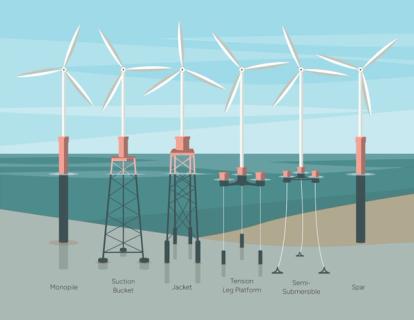
Offshore wind turbines and underwater noise: Impacts and mitigation for marine fauna
- Post Date
- 13 February 2024
- Author
- Justin Eickmeier
- Author
- Jonathan Vallarta
- Read Time
- 5 minutes

Offshore wind energy is a renewable and clean source of electricity that can help reduce greenhouse gas emissions and fossil fuel dependence. While this is positive for the environment, installing traditional offshore wind turbines using monopile foundations can generate underwater noise that may affect some marine species, which rely on sound for communication, navigation, foraging, and predator avoidance. We have reviewed and compiled some of the key research in this field to help you better understand the impacts and mitigation efforts available to protect marine fauna.
Problem: Sources and characteristics of underwater noise from offshore wind turbines
The main sources of underwater noise from offshore wind turbines come from the installation of mono-piles using pile driving (one of the most used foundation types amongst those shown in Figure 1), and dynamic positioning systems.
Pile driving is the process of hammering steel or concrete piles into the seabed to provide a foundation for the wind turbine. Pile driving generates impulsive noise that can spread over long distances and has high peak sound pressure levels.
Underwater noise from vessels equipped with dynamic positioning systems comes from the noise generated by the propellers and thrusters of the vessels that are used to transport and install the wind turbine components or to perform maintenance and repair. Underwater noise from vessels is continuous noise that can vary in sound pressure level and frequency depending on the vessel's speed, size, and type.
Both impulsive and continuous noise from offshore wind turbines can interfere with the natural soundscape of the marine environment and cause acoustic masking, behavioural changes, physiological stress, hearing impairment, or injury to.

Challenge: Impacts of underwater noise from offshore wind turbines on marine fauna
Many factors can play into the impact of underwater noise from offshore wind turbines. These include the species, the hearing sensitivity, the exposure duration, the distance from the noise source, and the ambient noise level. Marine mammals and fish have different hearing ranges and thresholds and may respond differently to underwater noise.
Marine mammals may exhibit behavioural changes, such as avoidance, displacement, changes in vocalization, swimming speed, diving pattern, or group cohesion, in response to underwater noise from offshore wind turbine installation. These behavioural changes may affect their vital functions, such as feeding, breeding, resting, or migrating. Marine mammals and fish may also experience physiological stress, such as increased heart rate, blood pressure, or cortisol levels, due to underwater noise from the installation of monopile foundations. Moreover, when conducting offshore pile driving, marine mammals and fish may suffer from hearing impairment, such as temporary or permanent threshold shifts, or injury, such as hemorrhage, rupture of auditory cells or swim bladder (in the case of some fish). These hearing impairments or injuries may reduce their ability to detect and avoid predators and prey while increasing their vulnerability to predation, starvation, or isolation. These physiological stress responses may impair their immune system, growth, or reproduction, leading to adverse effects on populations of both key species of prey (e.g. salmon) and at-risk foraging species (e.g. killer whales) during the installation of wind turbine foundations.
Solution: Methods to mitigate underwater noise from offshore wind turbines and protect marine fauna
There are a few things that can be done to mitigate underwater noise from the installation of monopile foundations and protect marine fauna during the installation of offshore wind turbines. These methods can be classified into four categories: source reduction, propagation reduction, receptor protection, and alternative foundations.
Source reduction methods aim to reduce the sound pressure level or frequency of the noise generated during the installation process by using low-noise vessels, such as electric or hybrid vessels, instead of conventional commercial vessels.
Propagation reduction methods aim to reduce the sound transmission or reflection of the impulsive noise generated by using bubble curtains, cofferdams, or acoustic barriers around the pile driving site.
Receptor protection methods aim to reduce the exposure or sensitivity of the marine fauna by using spatial or temporal planning, such as seasonal restrictions to avoid or minimize the overlap between the offshore wind turbine installation and the marine fauna habitats or migration routes.
Alternative foundation types (to traditional monopiles) allow for different installation methods, and often, pile driving activities can be reduced or avoided altogether.The use of floating turbines (such as tension leg platforms and semi-submersible platforms, as shown in Figure 1) can reduce underwater noise emissions to what is generated from limited site preparation (dredging) and offshore support vessels to deploy floating wind turbine foundations, moorings, and anchors.
These methods have different levels of effectiveness, feasibility, and cost. They may have trade-offs or unintended consequences, such as displacing marine fauna to less suitable habitats or attracting predators or competitors to the mitigation site.
Underwater noise is a clear by-product of marine construction activities. Nearly all species of marine fauna are at risk for permanent or temporary injury when pile driving (on the scale required for offshore marine turbine installation).SLR can help mitigate these risks by performing pre-construction sound transmission loss modelling, where sources of underwater noise and corresponding zones of impact can be evaluated and appropriate mitigation measures implemented before the sound is radiated into the water. SLR can also help to monitor underwater noise from ongoing marine construction operations to ensure sound levels due to harm to regional at-risk species.
This article was written using 10 peer-reviewed references published between 2010 and 2024 as source material, for the list of References or if you have any questions, please get in touch.

